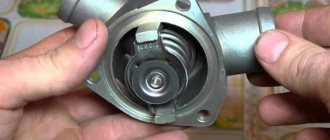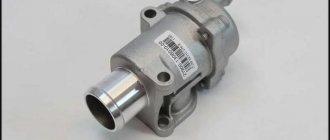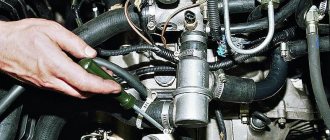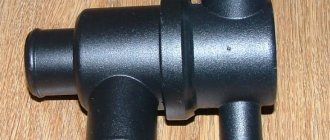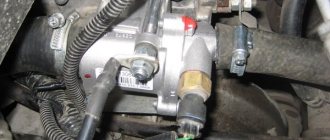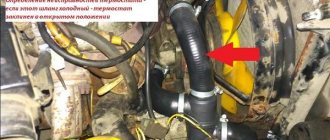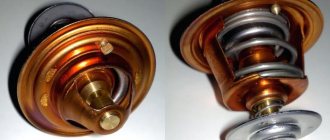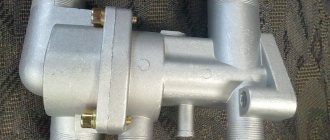Replacing the thermostat
Remove the air filter.
Drain the antifreeze into a prepared container.
Remove the four hoses by lowering the clamps. Keep in mind that a small amount of antifreeze may spill.
Carefully remove the thermostat.
We clean the nest from dust and other residues. We take a new thermostat and apply a layer of sealant to all joints with the hoses, then wait 10 minutes.
To further install the new thermostat, follow these instructions in reverse order:
- install four hoses;
- fill with coolant;
- install the air filter.
Removing the air filter housing
We unscrew the 2 nuts from the front and pull out the plug behind the body.
We remove the connector from the MAF sensor; you need to press the latch from below and pull the connector.
After loosening the clamp, carefully remove the air hose.
Slowly remove the air filter housing, slightly loosening it.
The filter is assembled in the same way, but in reverse order.
Purpose, design and principle of operation of the thermostat
The coolant circulating through the working channels of the engine blocks, its main purpose is to remove excess heat accumulated in the power unit due to the friction of the working elements of the engine and the impact of the high temperature of the exhaust gases passing through the exhaust circuit.
The main elements of the cooling system of the VAZ 2114, which are responsible for lowering the temperature of the antifreeze, are the electric cooling radiator fan and the thermostat.
To understand the principle of its operation, you need to see what the thermostat on a VAZ 2114 looks like. Structurally, it is designed in such a way that the valve that regulates the coolant flow is located inside a housing with three pipes:
- two inputs - from the engine and radiator;
- one day off - to the pump.
The main working element of the valve itself, located inside the thermostat, is a solid heat-sensitive filler, which, when heated, through a rubber insert, acts on the piston that moves the main valve. When it heats up, it opens it, when it cools down, on the contrary, it closes the hole, preventing the flow of antifreeze.
We recommend: Tread depth of winter and summer tires - permissible height
The thermostat is attached to the engine through a pipe to the cylinder head on the left side, under the air filter. It is connected to the radiator and pump using rubber pipes. On a cold engine, the valve of this coolant flow regulator is closed and after starting, the liquid that begins to be pumped by the pump forces moves along a “small circuit” or “in a small circle.” Both of these expressions are used among motorists. When moving in a small circle, the antifreeze passes through the heater radiator, intake manifold and throttle assembly. Liquid is not supplied to the radiator; the valve cuts off this path.
As the engine heats up, the coolant takes away some of the heat, heats up and, passing in a “small circle” through the thermostat, heats the temperature-sensitive element. The piston begins to move and open the main valve. This begins to happen when the liquid temperature reaches 87 degrees. In this case, part of the coolant begins to circulate through the radiator. When the temperature reaches 102 degrees, the valve opens completely, moving eight millimeters. In this mode, the entire coolant flow rushes in a “large circle” through the cooling radiator.
Experts recommend checking the operation of the thermostat without removing it from the car. To do this, after starting the engine, you need to touch the lower pipes coming from the radiator with your hands. They should be cold until the temperature rises above eighty degrees. As soon as the temperature rises above 85 degrees, the tubes should begin to heat up and after a while you can feel that the “large circle” circulation is working. The tubes should get quite hot.
If the lower pipes leaving the radiator continue to remain cold, it means the main valve has not opened and the thermostat is faulty. A malfunction of this regulator may also be indicated by the fact that the lower tubes begin to heat up almost immediately after starting the engine. This indicates that the valve is open and does not close when cold.
In both cases, a thermostat failure does not bring anything good for the engine. In the case when the valve is open, the antifreeze, passing in a “large circle,” does not have the opportunity to heat up to working condition. This reduces engine power and other performance parameters. In the case when the main valve is closed, the engine has a high risk of overheating the blocks. This is the most dangerous condition for the power unit. If you drive in this mode for some, even not very long, time, you can damage the engine, even to the point of breaking the shafts. And this, at a minimum, is a major overhaul of the entire internal combustion engine.
We recommend: How to clean carbon deposits on car spark plugs?
There is a different way to check the thermostat on a VAZ 2114. To do this, you need to pour water into a pan and, placing it on the stove to heat, immerse the thermostat there. Knowing at what temperature the thermostat on the VAZ 2114 opens, use a thermometer to monitor the heating of the water in the pan. At about 87 degrees the valve should open. If this happens, then the device is fully operational. It is better to check it in this way before installing it in place of a failed one.
Many car enthusiasts often ask specialists whether it is possible to repair the thermostat.
There is only one fairly reliable way to help the valve work. To do this, lightly hit the device body with a screwdriver several times. The impact should open the valve.
If this does not happen, then the thermostat on the VAZ 2114 needs to be replaced.
Checking the device
There is a very simple way to check the VAZ 2114 thermostat for a malfunction without removing it from the car - this is to check the lower radiator pipe. If the engine remains cold when running, this indicates a clear problem. In this case, the VAZ 2114 thermostat does not need to be dismantled, and if it is cold, this indicates that the valve is jammed and does not open.
It is also possible to test the removed thermostat at home. To do this, you need to place it in a pan of water. The water gradually heats up, at a temperature of 82 degrees the valve begins to open. If this does not happen, then it is faulty and must be replaced.
One of the most popular causes of failure is the formation of corrosion, which is why the valve may stop opening. The issue can be solved simply simply by cleaning the device and bringing it into proper shape. Corrosion can be removed with acetone or gasoline. After the corrosion has been removed, you need to put the thermostat back in place and check its functionality.
Checking a new thermostat before installation
Before replacing the VAZ-2114 thermostat, you need to check the functionality of the new one. The check is performed in the following order:
- Fill the container with water and place the device in it.
- Place the dish with the appliance on the stove and heat it, controlling the heating temperature.
We heat the water with the device, controlling the temperature
- When the temperature rises to 85˚C, the valve will open.
Purpose of the device
Thermostat for VAZ-2114 car
Essentially, a thermostat is a large valve whose task is to allow (or, conversely, not to allow) coolant into the car radiator . When the car's engine has just started, it remains cold for some time, as does the coolant. During this period of time, the thermostat valve is closed, so that the coolant is directed in the so-called small circle. And when the engine temperature reaches 90°C, the valve in the device automatically opens and the coolant begins to circulate in a large circle and enters the radiator. Thanks to this operating scheme, the engine temperature is kept at a constant level, and overheating is eliminated.
Causes and symptoms of thermostat malfunction
Being an important part of the car, the thermostat has many reasons for failure. The most common is corrosion.
Other reasons:
- The thermostat is stuck in the closed position. The consequence is engine overheating;
- the valve is stuck open. The consequence is that the engine takes time to warm up.
Signs indicating a device malfunction:
- the sensor arrow indicating the temperature is in the red (inadmissible) zone;
- in winter, the interior does not warm up well;
- the bypass valve sticks, the engine remains cold;
- the engine often overheats.
Thermostat replacement cost
There are many specialized salons offering thermostat replacement services. Its cost starts from 400 rubles.
It is important to choose the right thermostat. The main and main criterion is the metal from which the case is made. As already mentioned, the main cause of failure is corrosion. Chinese thermostats quickly become rusty. It is recommended to buy a case made of stainless metal or brass, which will serve you for many years without corroding.
Procedure for replacing the thermostat on a VAZ 2114
Having established that the coolant flow regulator is faulty, it is necessary to resolve the issue of replacing it. Before starting work, you need to prepare a new device, screwdrivers, keys for “12” and “13”, a sealing gasket, silicone sealant, antifreeze to replace the old one, a container for draining used coolant, new cooling system pipes.
We recommend: How to properly put covers on car seats - simple instructions for drivers
When choosing a new regulator, you need to find out which thermostat is better for the VAZ 2114 and how much the thermostat for the VAZ 2114 costs. You need to choose a device based on the price-quality ratio. The price of a VAZ 2114 thermostat ranges from 280 to 500 rubles.
To replace it, it is best to go to the inspection hole in the garage and give time for the engine to cool down before changing the thermostat on the VAZ 2114. Antifreeze should not be hot, otherwise you can get burned during operation.
- Open the hood and remove the air filter. Take this opportunity to check the condition of the filter element and replace it if necessary.
- Open the cap of the expansion tank and, opening the antifreeze drain plug on the radiator, drain the liquid into a specially prepared container.
- Loosen the clamps on the cooling system hoses that go to the flow regulator, including on the thermostat itself.
- Using wrenches, unscrew the studs and fastening nuts on the device body, removing the ground wire.
- Disconnect the hoses and, shaking slightly, disconnect the thermostat.
- Before installing a new device, you need to clean the mounting points and check the hoses. During operation, they crack and begin to leak antifreeze and air. Replace damaged hoses.
- Before installing a new thermostat, it is necessary to coat the pipes on its body with sealant and allow it to dry slightly.
- Install a new one in place of the old gasket, fasten the studs with nuts and put on the pipes. Carefully tighten the clamps and be sure to check the tightness of the connections.
- After first checking the closure of the drain plug, add fresh antifreeze in the required quantity.
- Start the engine and check that the valve of the newly installed thermostat opens at the desired temperature.
- Check the functionality of the heater radiator. If hot air flows evenly, then the antifreeze is filled correctly and there are no air pockets.
During operation, the driver must carefully monitor the operation of this important device and under no circumstances allow the engine to overheat.
Replacement or repair
Of course, it is possible to repair a broken device, but is it really that effective? If you consider the repair option, it is recommended that it be carried out exclusively in the field if you have the necessary tools. If the valve is not working, you can try to clean it in order to get to your destination. After this, it is recommended to immediately replace it.
The thermostat on the VAZ 2114 is a consumable item, the cost of which is not so high to try to repair it. Purchasing a new device guarantees its long service life, while a refurbished device may break down after just a few days. Therefore, in the event of a breakdown, it is recommended to install an analogue, even within 500 rubles, which can definitely last at least six months to a year.

